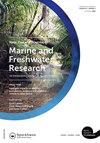塔斯曼海的高叶绿素和低叶绿素事件,它们与海洋热浪、寒冷期和全球遥相关的联系
IF 1.7
4区 环境科学与生态学
Q3 FISHERIES
New Zealand Journal of Marine and Freshwater Research
Pub Date : 2022-05-29
DOI:10.1080/00288330.2022.2076702
引用次数: 1
摘要
先前的研究表明,塔斯曼海的海洋热浪(MHW)和冷期(MCS)是对向东传播的南波数4大气压力波的失速的响应。我们研究了海面叶绿素(SSC)的极端值,定义了类似于MHW和MCS的高和低叶绿素事件(HCE和LCE),但使用的是塔斯曼海平均SSC异常。从2002年到2020年,有13例HCE和10例LCE,事件的频率、持续时间或强度没有变化迹象。HCE倾向于在塔斯曼海平均海表温度异常低时发生,LCE倾向于在塔斯曼海平均海表温度异常温暖时发生,但温度与叶绿素极值之间没有直接关系。从2002年到2020年形成的典型HCE/LCE表明,HCE/LCE也是由南波数4大气波驱动的。HCE发生在风胁迫增加后的低风胁迫时期,而LCE可能是强烈的垂直混合导致表层浮游植物向下混合的结果。这项工作的含义是,未来海洋中塔斯曼海初级产品的变化将取决于波数4的任何变化。本文章由计算机程序翻译,如有差异,请以英文原文为准。
Tasman Sea high- and low- chlorophyll events, their links to marine heat waves, cool spells, and global teleconnections
ABSTRACT Previous work has suggested that marine heat waves (MHW) and cool spells (MCS) in the Tasman Sea are responses to a stalling of an eastward propagating austral wavenumber-4 atmospheric pressure wave. We investigate extrema in sea surface chlorophyll (SSC), defining high- and low-chlorophyll events (HCE and LCE) analogous to MHW and MCS, but using Tasman-Sea averaged SSC anomalies. From 2002 to 2020, there were 13 HCE and 10 LCE, with no indication of changes in frequency, duration, or intensity of events. HCE tend to occur when Tasman-Sea averaged sea surface temperature is anomalously cool, and LCE tend to occur when Tasman-Sea averaged surface temperature is anomalously warm, however, there is no direct relationship between temperature and chlorophyll extrema. Canonical HCE/LCE formed from the 2002 to 2020 events suggest that HCE/LCE are also driven by the austral wavenumber-4 atmospheric wave. HCE occur during periods of low wind stress after a period of increased wind stress, whereas LCE may be a result of strong vertical mixing that mixes surface phytoplankton downwards. The implications of this work are that changes in Tasman Sea primary production in a future ocean will depend on any changes in the wavenumber-4 atmospheric wave.
求助全文
通过发布文献求助,成功后即可免费获取论文全文。
去求助
来源期刊
CiteScore
4.50
自引率
12.50%
发文量
35
审稿时长
3 months
期刊介绍:
Aims: The diversity of aquatic environments in the southern continents and oceans is of worldwide interest to researchers and resource managers in research institutions, museums, and other centres. The New Zealand Journal of Marine and Freshwater Research plays an important role in disseminating information on observational, experimental, theoretical and numerical research on the marine, estuarine and freshwater environments of the region.

 求助内容:
求助内容: 应助结果提醒方式:
应助结果提醒方式:


